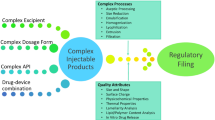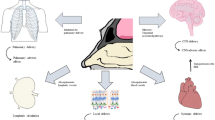ABSTRACT
Purpose
To investigate, for the first time, the performance of a dry powder inhaler (DPI, Aerolizer®) in the case of a model drug (i.e. albuterol sulphate) formulated with spray dried mannitol carrier particles with homogeneous shape and solid–state form but different sizes.
Methods
Spray dried mannitol (SDM) particles were characterized in terms of size, surface area, morphology, water content, solid–state, density and electrostatic charge by a novel approach. DPI formulations composed of SDM and albuterol sulphate (AS) were prepared and evaluated in terms of drug content homogeneity and in vitro aerosolization performance.
Results
All SDM particles generated similar fine particle fractions of AS. Formulations consisting of larger SDM particles demonstrated better drug content homogeneity, reduced amounts of drug loss and reduced oropharyngeal deposition. Comparing different SDM products demonstrated that SDM powders with relatively poorer flowability, wider size distributions and higher charge density generated DPI formulations with poorer drug content homogeneity and deposited higher amount of drug on the inhaler, mouthpiece adaptor and throat. DPI formulation total desirability increased linearly with the mean diameter of SDM.
Conclusion
Particle shape and solid–state form of mannitol could dominate over carrier size, bulk density, flowability and charge in terms of determining the aerosolization behaviour of AS formulated with mannitol carrier, at least within the experimental protocols applied in the present study.












Similar content being viewed by others
REFERENCES
Saint-Lorant G, Leterme P, Gayot A, Flament MP. Influence of carrier on the performance of dry powder inhalers. Int J Pharm. 2007;334(1–2):85–91.
Al-Qadi S, Grenha A, Carrión-Recio D, Seijo B, Remuñán-López C. Microencapsulated chitosan nanoparticles for pulmonary protein delivery: in vivo evaluation of insulin-loaded formulations. J Control Release. 2012;157(3):383–90.
Le VNP, Thi THH, Robins E, Flament M. Dry Powder Inhalers: Study of the Parameters Influencing Adhesion and Dispersion of Fluticasone Propionate. AAPS Pharm Sci Tech. 2012a:1–8.
Hassan MS, Lau R. Inhalation performance of pollen-shape carrier in dry powder formulation: effect of size and surface morphology. Int J Pharm. 2011;413:93–102.
Zeng XM, Martin GP, Marriott C. Particulate interactions in dry powder formulations for inhalation. Informa Health Care; 2001.
Traini D, Young PM, Thielmann F, Acharya M. The Influence of Lactose Pseudopolymorphic Form on Salbutamol Sulfate-Lactose Interactions in DPI Formulations. Drug Dev Ind Pharm. 2008;34(9):992–1001.
Byron PR, Jashnam R. Efficiency of aerosolization from dry powder blends of terbutaline sulfate and lactose NF with different particle-size distributions. Pharm Res. 1990;7:881.
Donovan MJ, Kim SH, Raman V, Smyth HD. Dry powder inhaler device influence on carrier particle performance. J Pharm Sci. 2012;101:1107.
Tee SK, Marriott C, Zeng XM, Martin GP. The use of different sugars as fine and coarse carriers for aerosolised salbutamol sulphate. Int J Pharm. 2000;208(1–2):111–23.
Shur J, Harris H, Jones MD, Kaerger JS, Price R. The role of fines in the modification of the fluidization and dispersion mechanism within dry powder inhaler formulations. Pharm Res. 2008;25(7):1631–40.
Cline D, Dalby R. Predicting the quality of powders for inhalation from surface energy and area. Pharm Res. 2002;19(9):1274–7.
Sethuraman VV, Hickey AJ. Powder properties and their influence on dry powder inhaler delivery of an antitubercular drug. AAPS PharmSciTech. 2002;3(4):7–16.
Bosquillon C, Lombry C, Preat V, Vanbever R. Influence of formulation excipients and physical characteristics of inhalation dry powders on their aerosolization performance. J Control Release. 2001;70(3):329–39.
Kaialy W, Larhrib H, Ticehurst MD, Nokhodchi A. Influence of batch cooling crystallization on mannitol physical properties and drug dispersion from dry powder inhalers. Cryst growth Des. 2012;12:3006–17.
Saleem I, Smyth H, Telko M. Prediction of dry powder inhaler formulation performance from surface energetics and blending dynamics. Drug Dev Ind Pharm. 2008;34(9):1002–10.
Kumon M, Machida S, Suzuki M, Kusai A, Yonemochi E, Terada K. Application and mechanism of inhalation profile improvement of DPI formulations by mechanofusion with magnesium stearate. Chem Pharm Bull. 2008;56(5):617–25.
Kaialy W, Alhalaweh A, Velaga SP, Nokhodchi A. Effect of carrier particle shape on dry powder inhaler performance. Int J Pharm. 2011;421:23.
Narayan P, Hancock B. The influence of particle size on the surface roughness of pharmaceutical excipient compacts. Mater Sci Eng, A. 2005;407(1):226–33.
Hüttenrauch R. Modification of starting materials to improve tabletting properties. Pharm Ind. 1983;45(4):435–40.
Van Campen L, Amidon G, Zografi G. Moisture sorption kinetics for water–soluble substances I: Theoretical considerations of heat transport control. J Pharm Sci. 1983;72(12):1381–8.
Zhu K, Tan RBH, Chen F, Ong KH, Heng PWS. Influence of particle wall adhesion on particle electrification in mixers. Int J Pharm. 2007;328(1):22–34.
Kaialy W, Martin GP, Larhrib H, Ticehurst MD, Kolosionek E, Nokhodchi A. The influence of physical properties and morphology of crystallised lactose on delivery of salbutamol sulphate from dry powder inhalers. Colloid Surface B. 2012;89:29–39.
Kaialy W, Momin MN, Ticehurst MD, Murphy J, Nokhodchi A. Engineered Mannitol as an alternative carrier to enhance deep lung penetration of salbutamol sulphate from dry powder inhaler. Colloid Surface B. 2010;79:345–56.
Kaialy W, Larhrib H, Martin GP, Nokhodchi A. The effect of engineered mannitol-lactose mixture on dry powder inhaler performance. Pharm Res. 2012;29:2139–56.
Mora CF, Kwan AKH. Sphericity, shape factor, and convexity measurement of coarse aggregate for concrete using digital image processing. Cem Concr Res. 2000;30(3):351–8.
Kaialy W, Nokhodchi A. Freeze-Dried Mannitol for Superior Pulmonary Drug Delivery via Dry Powder Inhaler. Pharm Res. 2012:1–20.
Kaialy W, Martin GP, Ticehurst MD, Royall P, Mohammad MA, Murphy J, et al. Characterisation and deposition studies of recrystallised lactose from binary mixtures of ethanol/butanol for improved drug delivery from dry powder inhalers. AAPS J. 2011;13:30–43.
Hussain T, Kaialy W, Deng T, Bradley MSA, Nokhodchi A, Armour-Chélu D. A novel sensing technique for measurement of magnitude and polarity of electrostatic charge distribution across individual particles. Int J Pharm. 2012;441:781–9.
Kaialy W, Ticehurst MD, Nokhodchi A. Dry powder Inhalers: mechanistic evaluation of lactose formulations containing salbutamol sulphate. Int J Pharm. 2012;423:184–94.
Karner S, Urbanetz NA. Triboelectric characteristics of mannitol based formulations for the application in Dry Powder Inhalers. Powder Technol. 2012;235:349–58.
Rowe RC, Sheskey PJ, Marian EQ. Handbook of pharmaceutical excipients. 2009: 424.
Das S, Larson I, Young P, Stewart P. Surface energy changes and their relationship with the dispersibility of salmeterol xinafoate powders for inhalation after storage at high RH. Eur J Pharm Sci. 2009;38(4):347–54.
Littringer EM, Noisternig MF, Mescher A, Schroettner H, Walzel P, Griesser UJ, Urbanetz. NA. The morphology and various densities of spray dried mannitol. Pow Technol. 2013;246:193–200.
Larhrib H, Cespi M, Dyas M, Roberts M, Ford J. Engineered carrier with a long time of flight (TOF) to improve drug delivery from dry powder inhalation aerosols. Drug Delivery to the Lung (DDL). 2006;17:304–7.
Adi H, Kwok PCL, Crapper J, Young PM, Traini D, Chan HK. Does electrostatic charge affect powder aerosolisation? J Pharm Sci. 2010;99(5):2455–61.
Staniforth JN. Performance-modifying influences in dry powder inhalation systems. Aerosol science and technol. 1995;22(4):346–53.
Pu Y, Mazumder M, Cooney C. Effects of electrostatic charging on pharmaceutical powder blending homogeneity. J Pharm Sci. 2009;98(7):2412–21.
Ho R, Wilson DA, Heng JYY. Crystal habits and the variation in surface energy heterogeneity. Cryst Growth Des. 2009;9(11):4907–11.
Schiavone H, Palakodaty S, Clark A, York P, Tzannis ST. Evaluation of SCF-engineered particle-based lactose blends in passive dry powder inhalers. Int J Pharm. 2004;281(1–2):55–66.
Heng D, Lee SH, Ng WK, Chan H-K, Kwek JW. Novel alternatives to reduce powder retention in the dry powderinhaler during aerosolization. Int J Pharm. 2013;452:194–200.
Shrimpton J. The challenge of predicting particle dynamics in dry powder inhalers.Proceedings of Drug Delivery to the Lungs 16, The Aerosol Society, London, UK, 2005, pp. 84–88.
Kaialy W, Ticehurst MD, Murphy J, Nokhodchi A. Improved aerosolization performance of salbutamol sulfate formulated with lactose crystallized from binary mixtures of ethanol—acetone. J Pharm Sci. 2011;100:2665–84.
ACKNOWLEDGMENTS AND DISCLOSURES
The authors thank Dr. I.J. Slipper (University of Greenwich) for help provided with SEM analyses. Waseem Kaialy and Ali Nokhodchi thank Dr. D. Tong (University of Greenwich) for access to powder charge analyses, as well as Dr. M. Maniruzzaman and Dr. D. Douroumis (University of Greenwich) for access to BET surface area analyses. Merck KGaA (Germany) is acknowledged for providing delta mannitol (Parteck® Delta M).
Author information
Authors and Affiliations
Corresponding author
Electronic supplementary material
Below is the link to the electronic supplementary material.
ESM 1
(DOCX 2.33 kb)
Rights and permissions
About this article
Cite this article
Kaialy, W., Hussain, T., Alhalaweh, A. et al. Towards a More Desirable Dry Powder Inhaler Formulation: Large Spray-Dried Mannitol Microspheres Outperform Small Microspheres. Pharm Res 31, 60–76 (2014). https://doi.org/10.1007/s11095-013-1132-2
Received:
Accepted:
Published:
Issue Date:
DOI: https://doi.org/10.1007/s11095-013-1132-2




